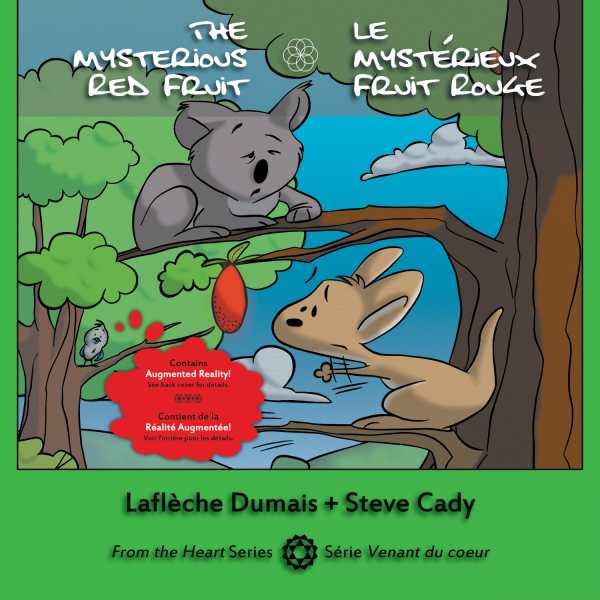
The Mysterious Red Fruit
Le Mystérieux Fruit Rouge
Polished and professional, The Mysterious Red Fruit would make a particularly good option for early language classes.
What’s better than a cute picture book? A cute picture book in multiple languages that features augmented reality—a description that perfectly fits The Mysterious Red Fruit (Le Mystérieux Fruit Rouge) by Laflèche Dumais.
The Mysterious Red Fruit tells the story of Jorgi, a young kangaroo whose parents head out to gather flowers and grass for dinner. They warn Jorgi not to eat the red fruit from the koala’s tree in the park, but his parents’ prohibition only makes it harder for the young kangaroo to resist.
Jorgi climbs out on a branch to grab a piece of the red fruit, but falls; the koala, Madame Kohana, gives him a piece to keep him quiet. Jorgi eats it, and soon discovers the reason for his parents’ warning, as his stomach is wracked with pain. His parents prepare a soup that cures Jorgi’s pain, and the book ends with a moral:
Sometimes, the more we shouldn’t have something, the more we want it. This is really mysterious.
The book’s layout is aesthetically pleasing. Every two-page spread has a full-color illustration on the left side, while on the right, the full text appears in both English and French, separated by a miniature, grayscale version of the color illustration. When this icon is viewed through a smartphone or tablet, using the free-to-download augmented reality application, a third translation, in Spanish, appears. As augmented reality goes, this may seem a pretty tame feature, but it does keep the book uncluttered for those not interested in the Spanish text, while offering a novel means of presentation for those who do.
More exciting is the use of augmented reality with the color illustrations, which allows the viewer to “move into” the picture, exploring the scene from different angles. A less technologically advanced but equally effective design choice is the use of oversized, boldface color type for key words, which not only emphasizes them, but also makes it easy to grasp certain vocabulary words in other languages.
For all of the “extras,” the story itself is very simple and straightforward: Jorgi disobeys, pays the price of a stomachache, and learns a lesson. More humor or suspense could have been generated from moments like Jorgi’s branch cracking and breaking, or his gastric distress after eating the red fruit, but the lighthearted illustrations make this an appealing book for young readers, especially those who might be reading a bilingual book for the first time.
Polished and professional, The Mysterious Red Fruit would make a particularly good option for early language classes.
Reviewed by
Peter Dabbene
Disclosure: This article is not an endorsement, but a review. The publisher of this book provided free copies of the book and paid a small fee to have their book reviewed by a professional reviewer. Foreword Reviews and Clarion Reviews make no guarantee that the publisher will receive a positive review. Foreword Magazine, Inc. is disclosing this in accordance with the Federal Trade Commission’s 16 CFR, Part 255.
